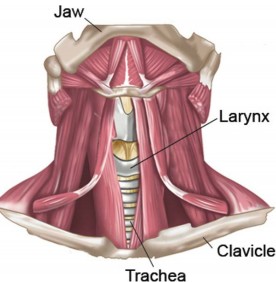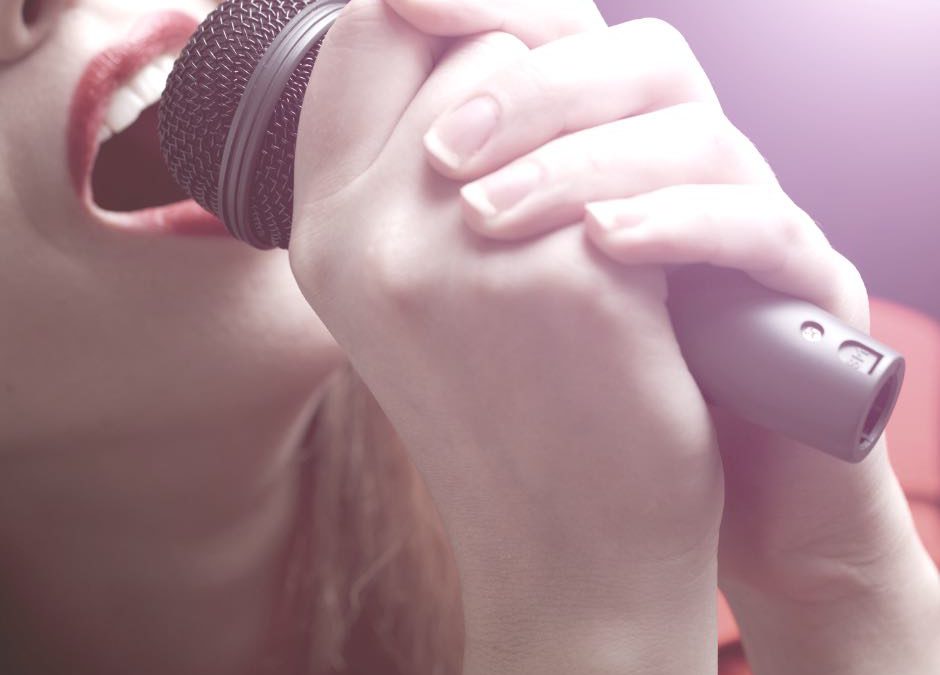December Holidays… even though the snow is late to show itself on the local mountains this winter, it is this time of the year you can wander the streets or the parks surrounded by festive lights, sipping your hot wine or apple cider while you sing Christmas Carols…perhaps thinking how bad your voice will be after your New Year’s celebration… About that, did you know that we can actually work on the voice with osteopathic treatments? With professional or amateur singers of course, but also with anyone who might be suffering from dysphonia or throat/voice issues.
A little anatomy to understand how our voice is working
The voice is an organic instrument, a very important one I would say, as its purpose is for us to communicate. It is constituted by the larynx (where the vocal chords are located), the thyroid and cricoid cartilages, and the hyoid bone. The hyoid bone is a unique bone in the way that it doesn’t articulate with any other bone, it’s completely suspended and serves as an attachment system for a lot of muscles and ligaments involved in the phonation process.


And what exactly is that phonation process? Well, the air in your lungs is pushed up to the larynx through the space between the vocal cords, the glottis. This will drop the pressure in the larynx which in turn will make the vocal cords to vibrate and create a sound. This raw sound will be filtered through the muscles in the mouth and throat called the vocal tract, such as the tongue, soft palate, hard palate etc. which are used in language production. The pitch of your voice will be altered by changes in the vibration of the vocal cords. Higher pitched sounds are caused by a faster vibration, and higher tension in the chords themselves, whereas lower pitched sounds are caused by a slower vibration and less tension.
Now imagine you had a bad fall while snowboarding, perhaps you land pretty hard on your ass after a jump you were attempting… yes I know, you are pretty awesome on a snowboard and your jumps are amazing but for the purpose of this article, let’s just pretend… So, such a fall will certainly impact the straightness of your pelvis and your body will have to adapt – because your body will do everything it can to keep your eyes straight and forward, levelled – your posture will change, your spine will twist a little, as will your head to compensate – this will inevitably affect the muscles in every area, including the ones holding the hyoid bone. And if you remember, this hyoid bone is serving as attachment for a lot of muscles in the throat and mouth, so it will impact them as well, inevitably creating imbalance, tension and strain in the vocal muscles. For professional singers it can even get worse as it may lead to overuse in muscles while they try to reach higher pitches of greater volume.
Falling, trauma and/or compensation patterns are not the only cause of vocal cord strain. Did you know that the psychological and emotional state of the person can impact your voice as well. For instance, anxiety can affect larynx pressure and vocal muscles tension and may lead to the same effects.
How can osteopathy help singers and professionals?
Osteopathy can be a great help to singers, actors, even politicians, to every professional who needs to talk in public, who needs his/her voice to be heard. How is that possible?
In osteopathy we consider the body as a whole, in its entirety, physical and psychological. We are looking for the root cause of the symptoms. So in our example (and it’s just an example, there could be so many different causes to the same symptoms) we’ll initially address the pelvis imbalance due to the fall and all the adaptations the body had to go through, to finally work on the throat itself. This might include: the hyoid bone, releasing the tensions in the vocal muscles, restoring pressure and alignment of the larynx. Your Osteopathic Practitioner will work to restore the vitality and function of this wonderful organ, so it can be as efficient as it can get, with no obstacles to a strong and powerful voice.
Occupational dysphonia
Occupational dysphonia, or work-related voice disorders, is characterized by an increased tension of the external laryngeal muscle which changes the position of the larynx and consequently disturbs the conditions of functioning of the vocal tract.
Your Osteopathic Practitioner will assess and address any postural issue(s) due (or not) to your work, any misalignment, malfunction, which, as discussed above, could affect directly and indirectly the way your throat and larynx are positioned and subsequently, functioning. This will improve the overall tension in the vocal muscles, the pressure in the larynx, and the functioning of the vocal tract, improving your occupational dysphonia.
Speech issues
Some speech issues (not all of them of course) are due to, or a participating cause is the discomfort and imbalance in the way the air is distributed from the lungs to the larynx. This can be influenced by what we’ve previously discussed and seen due to tensions in the vocal muscles or changes of pressure in the larynx. Osteopathic treatment in that case would be a good complementary therapy and a great way to potentiate the work of the voice therapist.
So yes, if you are a poor singer we won’t be able to give you the sense of the rhythm, we won’t make you sing in tune, but we can make your voice stronger. So basically, if you were a bad singer before, you’ll still be a bad just – just now with a more powerful voice 😉 and we’ll potentiate the work of your teacher to help improve your skills.
This kind of work can address a large range of people, so whether you are a professional who uses his voice every day, an adult suffering from occupational dysphonia, or a child with speech issues we can help you.
And if you’re still not sure whether or not we can do something for you, please feel free to contact and ask us any question you would have, we’ll gladly answer you.

